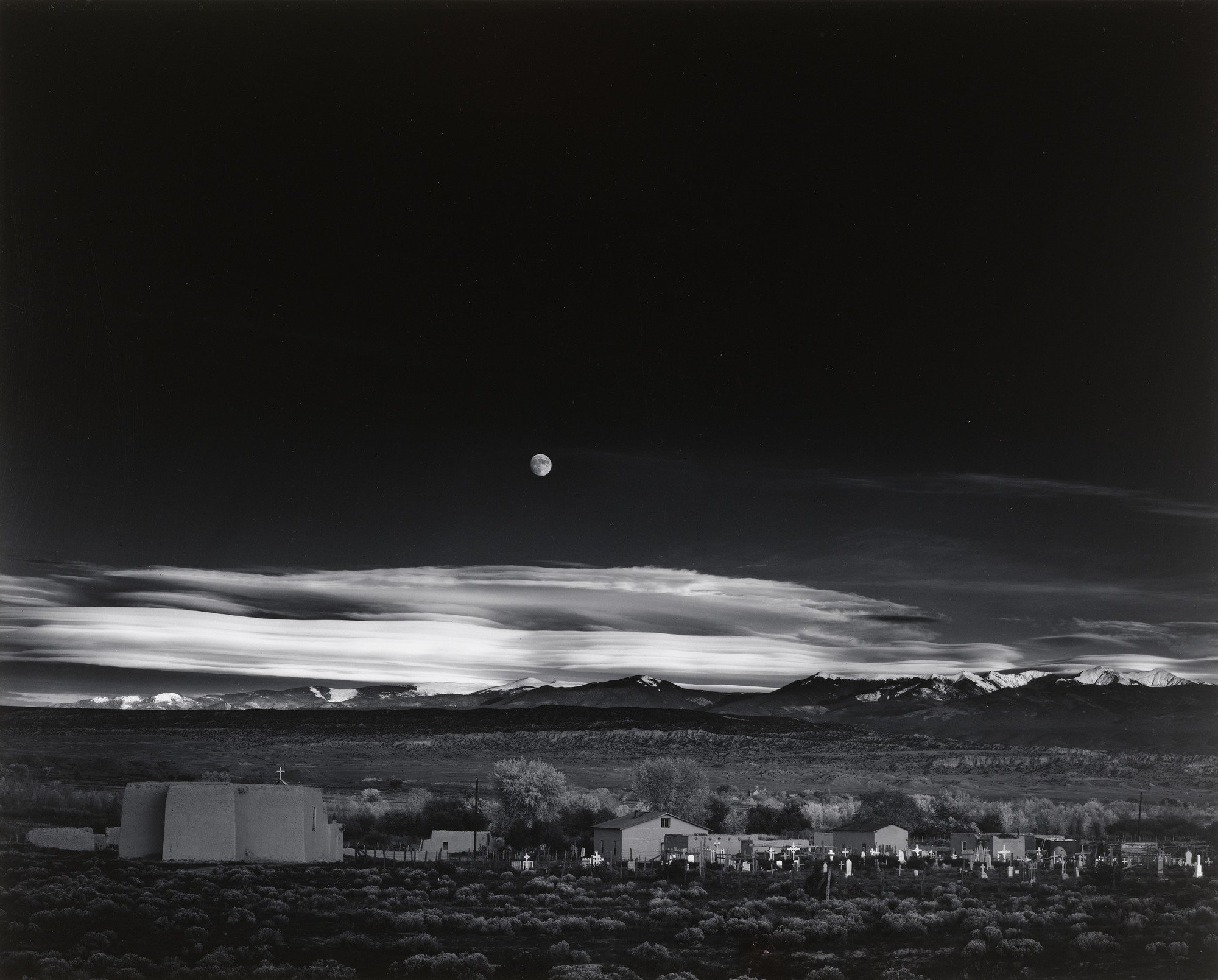Moonrise 80 Years Later
Today, November 1st, 2021 marks the 80th birthday of the creation of Ansel Adams’ monumental photograph “Moonrise, Hernandez, New Mexico.”
In the Autumn of 1941, Ansel Adams was in the middle of a six months long photography project for Secretary of the Interior Harold Ickes. Ickes hired Adams to create mural sized prints to be used for decorating the new Interior Museum in Washington D.C.
Adams, along with best friend Cedric Wright and son Michael were driving south, late in the day in the Chama River valley. As the car passed the graveyard in Hernandez, NM, Ansel eyed a spectacular scene out of the driver’s side window. The moon was rising low in the eastern sky. Simultaneously, the sun was setting in the west and reflecting perfectly off of the crosses in the graveyard. The car came to a screeching halt and Adams frantically began shouting orders and assembling his large format camera "Get this! Get that, for God's sake! We don't have much time!"
Adams’ recalls “I could not find my Weston exposure meter! The situation was desperate: the low sun was trailing the edge of clouds in the west, and shadow would soon dim the white crosses ... I suddenly realized that I knew the luminance of the Moon – 250 cd/ft2. Using the Exposure Formula, I placed this value on Zone VII ... Realizing as I released the shutter that I had an unusual photograph which deserved a duplicate negative, I quickly reversed the film holder, but as I pulled the darkslide, the sunlight passed from the white crosses; I was a few seconds too late! The lone negative suddenly became precious.”
Ansel knew he had made a great photograph. He printed the image more than 900 times over 40 years, and during that time, the image evolved greatly. Early examples had a lighter, less dramatic sky. In 1948, Adams bathed the negative in a chemical intensifier to increase the contrast in the foreground and make the moon brighter.
This image was printed in 1941-1942 (pre intensifier bath) and, while still gorgeous, does not impute the drama of the later images.
This image is more typical of the later, higher contrast prints that Adams produced.
Moonrise is a monumental achievement for several reasons.
Photography Craft Resulting in Preparedness
Ansel was truly a master of his craft and in 1941 he was at the peak of his abilities. Without a light meter he was able to calculate the exposure simply by knowing the footcandles of light reflected off of the moon. This goes along with my theory that you should continually improve your craft through practice, similarly to how a musician would prepare for a concert performance. In fact, Ansel Adams was a concert pianist, and the rigors of his practice in music gave him the work ethic to succeed in photography.
If you’re serious about making great photographs, shoot regularly. Do photo shoots with the intention of improving not necessarily making great photos every time. Attend workshops, and watch instructional videos on YouTube. Even if you’re an expert, you can always learn more!
Darkroom Craft and the Evolution of the Print
Adams knew the image was great when he made the exposure, but a full 7 years later, he was still making modifications to the negative. Adams’ abilities in the darkroom were remarkable. He gave a dodging and burning performance EVERY TIME he made the print. The modifications Adams made to the image during printing (compared to a straight print) would make even the most experienced Photoshop expert envious.
Photography as Fine Art
This image, along with several other images by Adams (most notably Monolith, the Face of Half Dome) really helped to establish photography as fine art. The scene itself is quite unremarkable. Hernandez, New Mexico is a completely unremarkable little town in the middle of nowhere. The image doesn’t contain any significant landmarks. There are no El Capitans, no Half Domes, no Grand Canyons, no Eiffel Towers in the image. It’s the way that Adams perceived the scene as art itself, and how he was able to transform that perception into a silver gelatin print that fellow human beings wanted to gaze at for decades that is the triumph.
It Illustrates Our Connection to the Universe
While the scene itself is quite unremarkable, the narrative of the image speaks to eternal grandeur. Ansel’s dark, black sky represents the eternity of time and the infinity of space. The moon gives a sense of how small we are, floating on this tiny rock called Earth, somewhere in the milky way galaxy. The light reflecting off of the crosses highlights, intensely, our own mortality and the ephemeral nature of our time here on earth.
In Conclusion
It’s easy to forget that this image was made completely with analog tools. No digital camera. No photoshop. No computers. I don’t even think Ansel had graduated filters when he created this photograph. As a manufacturer of filters, my first thought is “wow, imagine if Ansel had a 3 stop hard edge filter when he created the image! Printing would have been so much easier!”
But therein lies the genius of Ansel Adams, and it’s a good lesson for all of us to remember. We ALL have better cameras, lenses, filters, and post processing tools than Ansel had for the entirety of his career. So when you’re out shooting, make the most of the tools you’ve got in your bag. Become intensely familiar with your equipment, and then …
Make great photographs, not great excuses.


